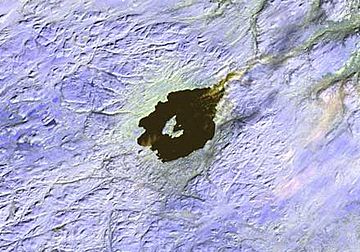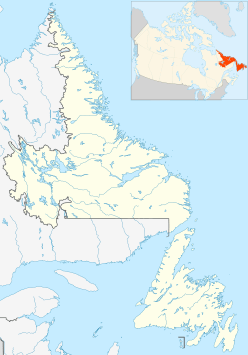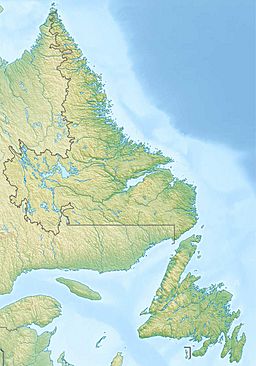Mistastin crater facts for kids
 |
|
| Impact crater/structure | |
|---|---|
| Confidence | Confirmed |
| Diameter | 19 kilometres (12 mi) |
| Age | 36.6 ± 2 million years old (Eocene Epoch) |
| Exposed | Yes |
| Drilled | Yes |
| Location | |
| Location | Labrador, Newfoundland and Labrador, Canada |
| Coordinates | 55°53′N 63°18′W / 55.883°N 63.300°W |
| Topo map | Canada NTS 13M |
| Mistastin Lake | |
|---|---|
| Coordinates | 55°53′N 63°18′W / 55.883°N 63.300°W |
| Type | Impact crater lake |
| Basin countries | Canada |
| Max. length | 19 km (12 mi) |
| Max. width | 12 km (7.5 mi) |
| Surface area | 145 km2 (56 sq mi) |
| Surface elevation | 338 metres (1,109 ft) |
| Islands | Mishta-minishtikᐡ |
The Mistastin crater is a huge hole in the ground in Labrador, Canada. It was made by a meteorite hitting the Earth a long time ago. Inside this crater, there is a round lake called Mistastin Lake.
The lake itself is about 16 kilometers (10 miles) wide. Scientists believe the original crater was much bigger, about 28 kilometers (17 miles) across. This amazing crater was formed about 36 million years ago, during a time called the Eocene Epoch.
How the Mistastin Crater Formed
The Mistastin crater was created by a very powerful asteroid impact. This happened about 36 million years ago. The crash was so strong that it made the ground incredibly hot.
Super Hot Rocks!
Scientists have found a special type of crystal called cubic zirconia around the edge of the crater. This shows that the impact created temperatures hotter than almost anything else known on Earth. It was even half as hot as the surface of the Sun!
These super high temperatures reached over 2,370 degrees Celsius (4,300 degrees Fahrenheit). The impact was so big that it caused changes all over the world. These changes lasted for many years after the asteroid hit.
Inside the Crater Lake
The island in the middle of Mistastin Lake is called Mishta-minishtikᐡ. Scientists think this island is actually the central part of the crater that bounced up after the huge impact.
The rocks that were hit by the asteroid were a mix of different types, like granite-like rocks. You can see many signs of the impact in the rocks on the island. These signs include special patterns in the rocks, melted glass, and cone-shaped rocks called shatter cones.




